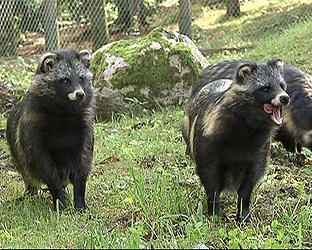Sweden Fears Racoon Dog Migration
 Experts in Sweden’s most southern province Skåne are worried about a possible invasion of racoon dogs, also known as magnuts. The animal already lives in northern Sweden but according to experts the threat is not from the north but rather from neighbouring Denmark.
Experts in Sweden’s most southern province Skåne are worried about a possible invasion of racoon dogs, also known as magnuts. The animal already lives in northern Sweden but according to experts the threat is not from the north but rather from neighbouring Denmark.
The racoon dog has managed to move from mainland Julland to the island Fyn in Denmark and Nils Carlsson, a wildlife expert at the county council, now say he is worried the animal could get over the narrow channel to Skåne.
This is a cause for concern, he says, since the racoon dog could bring with it diseases such as rabies and tapeworm that could be lethal to humans. Another problem with the animal is that it hunts birds nesting on the ground and rare amphibians.
In Finland the population of racoon dogs has grown uncontrollably and hundreds of thousands of them are hunted or killed in traffic every year. Sometimes the animals wander over the border to Sweden but the climate in the north is so harsh that only a small population can survive.
But there are effective measures to tackle the problem according to Carlsson.
One method means that hunters will capture one racoon dog which will then be treated for parasites and sterilised. A GPS transmitter will be attached to it so researches can follow the animal’s movements and use it to find other racoon dogs that will be killed.
“A racoon dog is about one thousand times better at tracking down other racoon dogs compared to humans. This is why we use them this way,” Carlson told newspaper Sydsvenska Dagbladet.
Experts in Sweden’s most southern province Skåne are worried about a possible invasion of racoon dogs, also known as magnuts. The animal already lives in northern Sweden but according to experts the threat is not from the north but rather from neighbouring Denmark.
The racoon dog has managed to move from mainland Julland to the island Fyn in Denmark and Nils Carlsson, a wildlife expert at the county council, now say he is worried the animal could get over the narrow channel to Skåne.
This is a cause for concern, he says, since the racoon dog could bring with it diseases such as rabies and tapeworm that could be lethal to humans. Another problem with the animal is that it hunts birds nesting on the ground and rare amphibians.
In Finland the population of racoon dogs has grown uncontrollably and hundreds of thousands of them are hunted or killed in traffic every year. Sometimes the animals wander over the border to Sweden but the climate in the north is so harsh that only a small population can survive.
But there are effective measures to tackle the problem according to Carlsson.
One method means that hunters will capture one racoon dog which will then be treated for parasites and sterilised. A GPS transmitter will be attached to it so researches can follow the animal’s movements and use it to find other racoon dogs that will be killed.
“A racoon dog is about one thousand times better at tracking down other racoon dogs compared to humans. This is why we use them this way,” Carlson told newspaper Sydsvenska Dagbladet.


